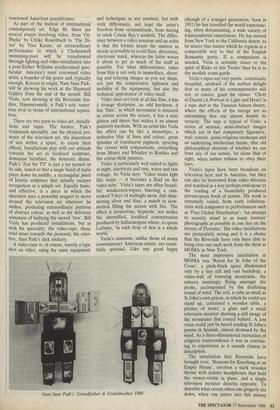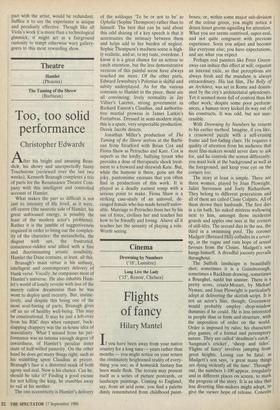Video art
Bill Viola (Riverside, till 9 October) Nam June Paik (Hayward, 29 September-11 December) Edge 88 (Clerkenwell, till 25 September)
Box of tricks
Adrian Dannatt
For most people video consists either of Jackie Chan's Best Ninja Kicks or taping Cousin Ray's wedding, making the term video art seem particularly inappropriate. Indeed video is one of those modern art forms whose very attraction is their lack of definition, particularly so since 'lack of definition', in the technical, broadcasting sense, is one of video's charms. Video is also a very un-British art medium: its major exponents tend to dwell either in the Far West or Far East, Japan and California being favoured partly for their advanced technology but also for their purity, of light and attitude.
British video art has revolved around dogmatic reiteration of the differences betweeen prime-time television and per- sonal experience, a quintessentially British way of turning an art medium of rare imaginative potential into a sectarian cul- de-sac. American video art is, as befits the national home of television, considerably more subtle and sophisticated, interested in video as an aesthetic in itself, not as a political tool. London presently has the opportunity to see a wide range of interna- tional video art, along with its two most renowned American practitioners.
As part of the festival of international contemporary art, Edge 88, there are several events involving video, from 'Or- Phelia' by Ulrike Rosenbach to 'The Di- ver' by Tina Keane, an extraordinary performance in which a Clerkenwell swimming-pool will be transformed through lighting and video-installation into a post-Esther Williams synchronised spec- tacular. America's most renowned video artist, a founder of the genre and, typically enough, Korean in origin, Nam June Paik, will be showing his work at the Hayward Gallery from the end of the month. Bill Viola, now showing at the Riverside Stu- dios, Hammersmith, is Paik's sole Amer- ican rival in terms of international reputa- tion.
There are two parts to video art, installa- tions and tapes. The former, Paik's trademark speciality, use the physical pre- sence of the television set, the placement of sets within a space, to create their effects. Installations play with our attitude towards the set as localised sculpture, dominant furniture, the domestic shrine. Paik's 'Zen for TV' is just a set turned on its side, tuned so that a single band of static plays down its middle, a rectangular piece of kinetic sculpture that initially escapes recognition as a simple set. Equally basic, and effective, is a piece in which the spectator uses a powerful magnet to move around the television set wherever he wishes, producing extraordinary patterns of abstract colour, as well as the delicious sensation of bullying the sacred 'box'. Bill Viola has produced installations, but as with his speciality, the video-tape, these tend more towards the personal, the emo- tive, than Paik's slick trickery.
A video-tape is, of course, merely a tape shot on video, using the same equipment and techniques as any amateur, but with rank differences, not least the artist's freedom from verisimilitude, from having to catch Cousin Ray's confetti. The differ- ence between a video amateur and an artist is that the former keeps the camera as steady as possible to avoid flare, distortion, electronic muck, whereas the latter waves it about to get as much of the stuff as possible. For what differentiates video from film is not only its immediacy, shoot- ing and relaying images as you see them, not just the comparative lightness and mobility of the equipment, but also the technical appearance of video itself.
Video does not look at all like film; it has a strange sharpness, an odd hardness, it has 'flare', in which movement is smeared as colour across the screen, it has a sexy glisten and sheen that makes it an almost painterly medium. With an artist like Viola the effect can be like a monotype, a seductive blur of lines and colour, great splashes of translucent pigment, spraying the viewer with comparisons, everything from Monet and Whistler to Rothko and the colour-field painters.
Video is particularly well suited to lights at night, electricity and rain, water and raw voltage. As Viola says: 'Video treats light like water -- it becomes a fluid on the video tube.' Viola's tapes are often beauti- ful: windscreen-wipers blurring a rain- soaked Tokyo of midnight neon, fish shim- mering silver and blue, a match in slow- motion filling the screen with fire. The effect is mysterious, hypnotic, not unlike the intensified, localised concentration produced by hallucinogens where, to quote Leibnitz, 'in each drop of dew is a whole world.'
Viola's concerns, unlike those of many contemporary American artists, are essen- tially spiritual. Like any good hippy Nam June Paik's 'Grandfather & Grandmother 1986' (though of a younger generation, born in 1951) he has travelled the world experienc- ing, often documenting, a wide variety of transcendental experiences. He has moved from New York to the California desert, to be nearer that nature which he regards in a comparable way to that of the English Romantic poets. If a comparison is needed, Viola is certainly closer to the spirit of Blake or late Turner than he is to the modish avant-garde.
Viola's tapes are very poetic, consciously beautiful, unafraid of the surface delight that so many of his contemporaries will not, or cannot, grant the viewer. `Chott el-Djerid (A Portrait in Light and Heat)' is a tape shot in the Tunisian Sahara desert, where the effects of the mirage are so astonishing that one almost doubts its veracity. The tape is typical of Viola: a series of sensual, semi-abstract images which are in fact completely figurative, real; remote, quasi-religious landscape and an underlying intellectual theme, that old philosophical chestnut of whether we can trust any of our senses, let alone that of sight, when nature refuses to obey their laws.
Viola's tapes have been broadcast on television here and in America, but they can also be borrowed from video libraries and watched in a way perhaps analogous to the reading of a beautifully produced private-press book of poems. His work is extremely varied, from early collabora- tions with composers to performances such as 'Free Global Distribution': 'An attempt to secretly stand in as many tourists' photographs as possible in one day on the streets of Florence.' His video installations are particularly strong and it is a shame that the Riverside have only been able to bring over one such work from the show at MOMA in New York.
The most impressive installation at MOMA was 'Room for St John of the Cross': a pitch-black space illuminated only by a tiny cell and vast backdrop, a video-wall of towering mountains, the camera seemingly flying amongst the peaks, accompanied by the deafening sound of wind. The cell, a cube as small as St John's own prison, in which he could not stand up, contained a wooden table, a pitcher of water, a glass and a small television monitor showing a still image of the mountains that roared behind. A low voice could just be heard reading St John's poems in Spanish, almost drowned by the wind. As a three-dimensional recreation of religious transcendence it was as convinc- ing to experience as it sounds clumsy in description.
The installation that Riverside have brought over, 'Reasons for Knocking at an Empty House', involves a stark wooden throne with sinister headphones that hold the viewer-victim in place, and a single television monitor directly opposite. To describe what occurs when one gingerly sits down, when one enters into this uneasy pact with the artist, would be redundant. Suffice it to say the experience is unique and peculiarly effective. Though like all Viola's work it is more than a technological gimmick, it might act as a fairground curiosity to tempt otherwise wary gallery- goers to this most rewarding show.




































































 Previous page
Previous page